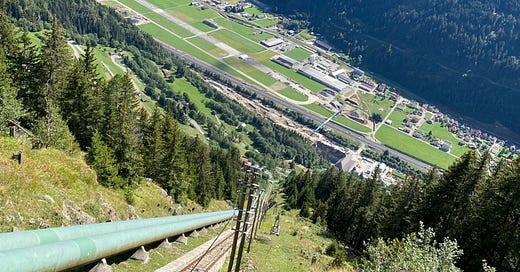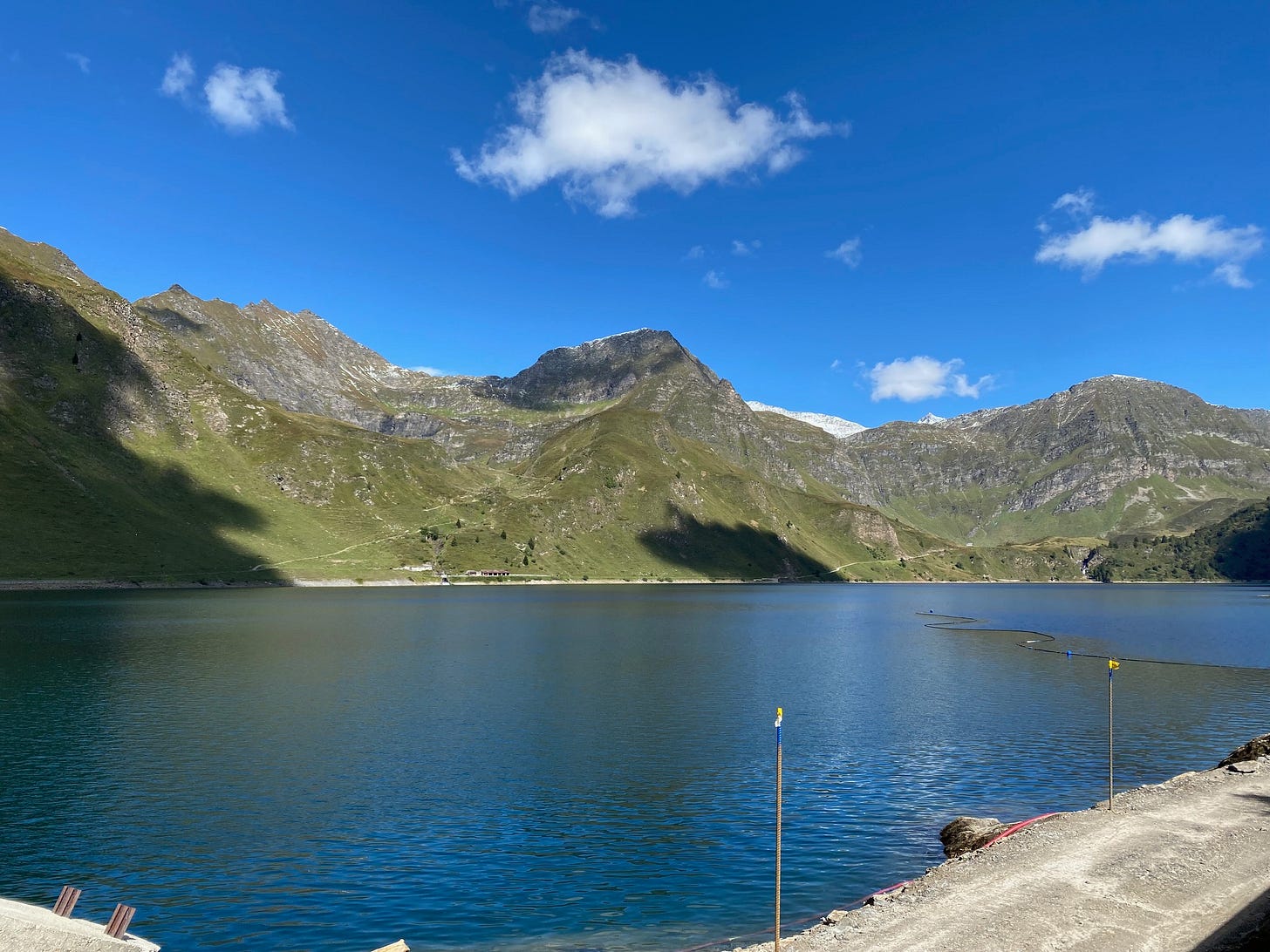36 hours in Ambri-Piotta
Come for the cows, stick around for the full write-up at The Hockey News
The villages of Ambri and Piotta in Italian-speaking Ticino are home to a combined population of around 700 people. The noise the two villages generate is figuratively broadcast across the hockey world by their renowned ultras groups, particularly Gioventu Biancoblu. Translated to the “blue and white youth,” these fans are well known in hockey circles as impassioned supporters that define the Hockey Club of Ambri-Piotta as among the most revered, if not actually successful, clubs in Switzerland whose reputation extends well beyond their cantonal borders. For decades they made the raucous Valascia, their open-ended, freezing cold, avalanche-prone, outdated but charmingly throwback home one of the most demanding places to play as an opponent.
But as for the less figurative and more day-to-day sounds in these quiet villages, you don’t have to try hard to hear the livestock. There are a lot of cows. With bells.
After the crowds dispersed Tuesday night from the brand new Nuova Valascia arena, now three games into its soft opening, the charming sounds of this glacially-carved valley 80 miles north of the Italian border and two towns south of the Gotthard Road Tunnel, returned to faint clanging in all directions. Whether in the morning, at night, above Funiculare Ritom and the massive Lago Ritom reservoir it ascends towards, or next to the vintage Valascia itself, the cows are there, idling, as cows do. And when these cows are provoked enough to shift from idling to the much more active loitering, their bells announce their movement to all crannies of the narrow valley.
It is a soothing and unfamiliar sound for those who grew up in Los Angeles.
I had 20 minutes to kill Tuesday morning while waiting to meet with Matteo, HC Ambri-Piotta’s communications director, so I took a short drive to the old Valascia to take photos of the rink that was denied a proper send-off by coronavirus. Libertarian rule application in small-town Switzerland provided the easy access I needed to the rink, which, had I not been content to photograph from above a gate blocking the main entrance, would have easily allowed me to stand at what used to be the red line by hopping one of a half-dozen scalable barriers.
And directly next to the old stadium, where Ambri improbably played in the top Swiss hockey league without having been relegated since their 1985 arrival, there was a corral where 10 or so cows stood lazily. There were three men monitoring these cows as another conversed with them from behind a gate, and all were content – bovine and man alike – to continue their languid conversation on a beautiful morning without having to face the underlying acknowledgement that these cows would ultimately have to be fed, or milked, or moved somewhere. Whatever one does when shepherding cows.
I thought this poetic juxtaposition of the herd and the hockey rink would make a good picture. So, I walked towards the corral, and before I could ask permission to take a photo – one does not clandestinely photograph cows and then sprint away – the man outside the pen turned towards me with a friendly smile to see why the guy taking pictures of the old hockey rink was all of a sudden upon them.
He and the others spoke little English, and when I tried using the four words I know in Italian, he responded in German. Regardless of what I’d said, or how it was interpreted, I mimicked taking a photograph of the cows and asked “Is it OK?” and all responded yes. I used “giornaliste” to explain what I was doing there, not knowing the word for “sportswriter” in German. They understood.
The man outside the pen then said something I didn’t understand and pointed to my feet. No interpreter was needed. Don’t Step In That Cow Shit. It was such a large dropping, and so close to both of my shoes I was amazed that in my own loitering and idling I hadn’t stepped in it. I looked at my shoes, and both were clean. We all found this amusing. This was a reenactment of Jules and Vincent inexplicably avoiding being hit in Pulp Fiction’s Big Kahuna Burger scene, but replacing the bullets with cow shit.
* * * * *
Even atop the Ritom Funicular, some 6,000 feet above sea level and 3,000 feet above the valley, the sound of clanging cow bells from a mid-mountain pasture was audible. It was beautiful, idyllic. It was one of those mild days in which it was too warm for a sweatshirt and too cool to wear a tee. On a 20-minute walk from the top of the funicular to Lago Ritom, I must have pulled the sleeves on my long-sleeved shirt up and down 20 times. The air smelled like pine mountain air, much more so than in the valley. In addition to the clanging, the only other sound apart from the occasional passing cars was of a helicopter loading industrial supplies in Ambri and flying them to a construction station midway up the massif across the valley.
There was quite a bit of engineering work on our mountain, as well. The funicular was built to access Lago Ritom, a reservoir that pools water from the surrounding peaks and is transported via tube to a power station at the base of the funicular in Piotta.
Though it provided a spectacular view, this wasn’t one of the famous Swiss cog railways or cable cars like those reaching Jungfraujoch or the Matterhorn. The track was laid over 100 years ago to transport workers, goods and materials up and down the side of a mountain during the construction of the Lago Ritom dam and was shortly thereafter opened to the public. At one point the funicular was the steepest in the world, yet another indicator of the marvels of Swiss engineering.
Everywhere one can travel in Switzerland such ingenuity is visible. The cable cars, the railways, the massive tunnels through sheer rock, the winding highways clinging to ridges suspended over stunning lakes are all incredible. I’ve never taken the Gotthard Base Tunnel, which at 35.5 miles is the longest transport-accessible tunnel in the world, but the 10.5-mile Gotthard Road Tunnel was plenty impressive itself, and the road tunnels south of Zurich in the pre-Alps that sprouted auxiliary tunnel off-shoots from the arterial highway were enjoyable to drive through and admire. Not that the Swiss didn’t make any mistakes in their construction, but it does call to mind the infrastructural shortcomings and overruns that have plagued American tunnel projects, like Boston’s Big Dig, or the hypothetical California High Speed Rail tunnels east of Tehachapi that supposedly within our lifetimes will connect the Southland to the rest of the boondoggle system.
* * * * *
And then it was time to put on slacks. I set gear down at Nuova Valascia at 4:45 and spoke with Alessandro Benin, HCAP’s assistant sports director and a European scout for the Everett Silvertips, my old major junior club. Austrian forward Dominic Zwerger has played five seasons with Ambri since he aged out of the WHL after his 20-year-old season with Everett. Brandon Kozun also played in the WHL before he joined the Kings organization; I missed him by two weeks on my 2014 Manchester Monarchs Insider assignment when he was traded to Toronto. It was great to catch up with him, as it was to see Brandon McMillan, who was part of the Kelowna team that upset my ‘Tips in 2010, and whom I covered again as an Anaheim beat writer in 2011-12. The hockey world is a small world.
Scaffolding still hung from the exterior of Nuova Valascia as a metaphor of what this small club is trying to build in the short, middle and long-term. It’s a beautiful building just off the taxiway of a decommissioned air force base that is apparently still used as a general aviation airport. Given the cliffs on both sides of this airport and the rising mountains encroaching, do not ask me to fly out of it. Don’t ask me to fly out of any airport, as I am not a pilot, but especially this one.
Ambri got off to a hot start, winning its first three games, including a road win at Zurich, the team with the largest budget in the National League. They won the first game at Nuova Valascia, 6-2. (The official opening and dedication will take place later this fall.) But they’d hit a skid just before I’d arrived, and on this night the hockey gods were kinder to the visiting Rapperswil-Jona Lakers, whom I’d seen lose 9-0 at Lugano on my last trip to cover European hockey during the 2012 work stoppage. Jason Spezza played for Rapperswil-Jona that night, while Patrice Bergeron and Luca Sbisa suited up for Lugano.
Though Ambri had the better opportunities early, including several rush chances created by Kozun in which he found the trailing high forward for a Grade-A chance, their scoring dried up and they fell, 3-0, surrendering all three goals in a second period in which former Calgary Flames forward Roman Cervenka converted a penalty shot after an Ambri player gloved a puck in the crease. (Referees: call that penalty shot more often in beer league hockey.)
So there would be no rendition of La Montanara – the Swiss-Italian alpine folk song sung by Ambri-Piotta supporters after a win – on this night. But having shared prosciutto and cheese and a glass of wine with HCAP President and former Councillor in Switzerland’s upper Federal Assembly Filippo Lombardi, and chatting with their hockey operations staff well after I’d turned my voice recorder off, who in their right mind could complain? I experienced Valascia, old and new, I visited the team in their temporary office at a small-town train station, I drove to and from Italian-speaking Switzerland through the Alps, crossing a topographical border that had been crossed for a millennium before me. I met those who have breathed the same air in Everett, Washington. There’s much, much more detail to come in The Hockey News, a little bit less cow shit, and more stories and adventures to write about in Berlin, Erfurt and Helsinki.








